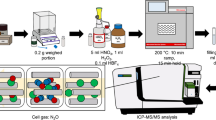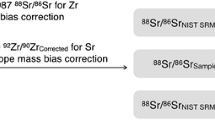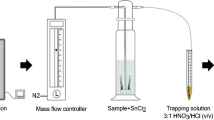Abstract
The aim of this work is to evaluate two quantitative methods, based on the external calibration applied in laser ablation inductively coupled plasma mass spectrometry (LA-ICP-MS) analysis, known as (i) analytical curve and (ii) one-point calibration, using the concept of matrix matching to quantify three potentially toxic elements (PTEs) in wood samples. These can biologically register changes in the abiotic environment and be applied to monitoring climate change or environmental toxicity. In this case, standard sample preparation was evaluated to prepare the standard pellets using Pinus taeda species as a matrix-matching concept. Six pellets of P. taeda, with different Pb, Cd, and Ba concentrations, were prepared to build the analytical curve and one-point calibration strategies. The LA-ICP-MS parameters were optimised for 206Pb, 208Pb, 112Cd, 114Cd, 137Ba, and 138Ba isotope analysis in wood samples. The two calibration strategies provided 74–110% analytical recovery from certified reference materials and similar results to those obtained by ICP-MS through the acid digestion of environmental wood samples from São Paulo City (Brazil). This demonstrated the applicability of the one-point calibration strategy in quantifying PTEs in wood samples, which could be used with environmental analyses. Differences observed between the Ba isotope results obtained via LA-ICP-MS and ICP-MS quantification were related to sampling by LA-ICP-MS and the ICP-MS sample introduction, as well as to laser matrix and transport effects because of the difference between the wood species evaluated.

Similar content being viewed by others
References
Burns SJ, Welsh LK, Scroxton N, Cheng H, Edwards RL. Millennial and orbital scale variability of the South American Monsoon during the penultimate glacial period. Sci Rep. 2019;9:4–8. https://doi.org/10.1038/s41598-018-37854-3.
Locosselli GM, Chaccon-Madrid K, Arruda MAZA, Camargo EP, Moreira TCL, Singer JM, André PA, André CDS, Buckeridge MS. Tree rings reveal the reduction of Cd, Cu, Ni and Pb pollution in the central region of São Paulo, Brazil. Environ Pollut. 2018;242:320–8. https://doi.org/10.1016/j.envpol.2018.06.098.
Pearson C, Manning SW, Coleman M, Jarvis K. Can tree-ring chemistry reveal absolute dates for past volcanic eruptions? J Archaeol Sci. 2005;32:1265–74. https://doi.org/10.1016/j.jas.2005.03.007.
Watmough SA. Monitoring historical changes in soil and atmospheric trace metal levels by dendrochemical analysis. Environ Pollut. 1999;106:391–403. https://doi.org/10.1016/S0269-7491(99)00102-5.
dos Santos SL, Viana LF, Merey FM, do Amaral Crispim B, Solorzano JC, Barufatti A, Cardoso CAL, Lima-Junior SE. Evaluation of the water quality in a conservation unit in Central-West Brazil: Metals concentrations and genotoxicity in situ. Chemosphere. 2020;251:126365. https://doi.org/10.1016/j.chemosphere.2020.126365.
Seo E, Kim S, Park J, Lim H, Ha N, Lim J, Lim JH, Park HJ, Kim KH, Lee SJ. Foliar uptake of the potencially toxic elements in garlic chive leaves. Front Environ Sci. 2021;9:1–11. https://doi.org/10.3389/fenvs.2021.702490.
Shaheen SM, Tsadilas CD, Rinklebe J. A review of the distribution coefficients of trace elements in soils: influence of sorption system, element characteristics, and soil colloidal properties. Adv Colloid Interface Sci. 2013;201–202:43–56. https://doi.org/10.1016/j.cis.2013.10.005.
US-EPA. Basic Information about Lead Air Pollution. In: United States Environ. Prot. Agency. https://www.epa.gov/lead-air-pollution/basic-information-about-lead-air-pollution. Accessed 1 Jan 2023, 2022.
Sternbeck J, Sjödin Å, Andréasson K. Metal emissions from road traffic and the influence of resuspension - Results from two tunnel studies. Atmos Environ. 2002;36:4735–44. https://doi.org/10.1016/S1352-2310(02)00561-7.
US-EPA. Locating and estimating air emissions from sources of cadmium and cadmium compounds. United States Environ Prot Agency 1993.
US-EPA. Air pollution aspects pf barium and its compounds. United States Environ Prot Agency 1969.
Gundlach-Graham A, Burger M, Allner S, Schwarz G, Wang HAO, Gyr L, Grolimund D, Hattendorf B, Günther D. High-speed, high-resolution, multielemental laser ablation-inductively coupled plasma-time-of-flight mass spectrometry imaging: part I. Instrumentation and two-dimensional imaging of geological samples. Anal Chem. 2015;87:8250–8. https://doi.org/10.1021/acs.analchem.5b01196.
Francischini DS, Arruda MAZ. When a picture is worth a thousand words: molecular and elemental imaging applied to environmental analysis – A review. Microchem J. 2021;169:106526. https://doi.org/10.1016/j.microc.2021.106526.
Sussulini A, Becker JS, Becker JS. Laser ablation ICP-MS: application in biomedical research. Mass Spectrom Rev. 2017;36:47–57. https://doi.org/10.1002/mas.21481.
Van Acker T, Buckle T, Van Malderen SJM, van Willigen DM, van Unen V, van Leeuwen FWB, Vanhaecke F. High-resolution imaging and single-cell analysis via laser ablation-inductively coupled plasma-mass spectrometry for the determination of membranous receptor expression levels in breast cancer cell lines using receptor-specific hybrid tracers. Anal Chim Acta. 2019;1074:43–53. https://doi.org/10.1016/j.aca.2019.04.064.
Dumková J, Smutná T, Vrlíková L, Dočekal B, Kristeková D, Večeřa Z, Husáková Z, Jakešová V, Jedličková A, Mikuška P, Alexa L, Coufalík P, Tvrdoňová M, Křůmal K, Vaculovič T, Kanický V, Hampl A, Buchtová M. A clearance period after soluble lead nanoparticle inhalation did not ameliorate the negative effects on target tissues due to decreased immune response. Int J Mol Sci. 2020;21:1–27. https://doi.org/10.3390/ijms21228738.
Gundlach-Graham A, Garofalo PS, Schwarz G, Redi D, Günther D. High-resolution, quantitative element imaging of an upper crust, low-angle cataclasite (Zuccale Fault, Northern Apennines) by laser ablation ICP time-of-flight mass spectrometry. Geostand Geoanalytical Res. 2018;42:559–74. https://doi.org/10.1111/ggr.12233.
Mokgalaka NS, Torresdey JLG. Laser ablation inductively coupled plasma mass spectrometry: principles and applications. Appl Spectrosc Rev. 2006;41:131–50. https://doi.org/10.1080/05704920500510703.
Koch J, Günther D. Laser ablation inductively coupled plasma mass spectrometry. Encycl Spectrosc Spectrom 2017;526–532. https://doi.org/10.1016/B978-0-12-803224-4.00024-8
Limbeck A, Galler P, Bonta M, Bauer G, Nischkauer W, Vanhaecke F. Recent advances in quantitative LA-ICP-MS analysis: challenges and solutions in the life sciences and environmental chemistry. Anal Bioanal Chem. 2015;407:6593–617. https://doi.org/10.1007/s00216-015-8858-0.
Costa VC, Babos DV, Castro JP, Andrade DF, Gamela RR, Machado RC, Sperança MA, Araújo AS, Garcia JA, Pereira-Filho ER. Calibration strategies applied to laser-induced breakdown spectroscopy: a critical review of advances and challenges. J Braz Chem Soc. 2020;31:2439–51. https://doi.org/10.21577/0103-5053.20200175.
Pessôa GDS, Lopes CA, Madrid KC, Arruda MAZ. A quantitative approach for Cd, Cu, Fe and Mn through laser ablation imaging for evaluating the translocation and accumulation of metals in sun flower seeds. Talanta. 2017;167:317–24. https://doi.org/10.1016/j.talanta.2017.02.029.
Chacón-Madrid K, Arruda MAZ. Internal standard evaluation for bioimaging soybean leaves through laser ablation inductively coupled plasma mass spectrometry: a plant nanotechnology approach. J Anal At Spectrom. 2018;33:1720–8. https://doi.org/10.1039/c8ja00254a.
Papaslioti EM, Parviainen A, Alpiste MJR, Marchesi C, Garrido CJ. Quantification of potentially toxic elements in food material by laser ablation-inductively coupled plasma-mass spectrometry (LA-ICP-MS) via pressed pellets. Food Chem. 2019;274:726–32. https://doi.org/10.1016/j.foodchem.2018.08.118.
dos Santos Moreau P, Arruda MAZ. Direct analysis of tree rings using laser ablation-ICP-MS and quantitative evaluation of Zn and Cu using filter paper as a solid support for calibration. J Anal At Spectrom. 2022;37:795–804. https://doi.org/10.1039/d1ja00414j.
Hirata J, Takahashi K, Sahoo YV, Tanaka M. Laser ablation inductively coupled plasma mass spectrometry for quantitative imaging of elements in ferromanganese nodule. Chem Geol. 2016;427:65–72. https://doi.org/10.1016/j.chemgeo.2016.02.017.
Jochum KP, Stoll B, Herwig K, Willbold M. Validation of LA-ICP-MS trace element analysis of geological glasses using a new solid-state 193 nm Nd:YAG laser and matrix-matched calibration. J Anal At Spectrom. 2007;22:112–21. https://doi.org/10.1039/b609547j.
Santos MC, Wagner M, Wu B, Scheider J, Oehlmann J, Cadore S, Becker JS. Biomonitoring of metal contamination in a marine prosobranch snail (Nassarius reticulatus) by imaging laser ablation inductively coupled plasma mass spectrometry (LA-ICP-MS). Talanta. 2009;80:428–33. https://doi.org/10.1016/j.talanta.2009.06.080.
Jochum KP, Scholz D, Stoll B, Weis U, Wilson SA, Yang Q, Schwalb A, Börner N, Jacob DE, Andreae MO. Accurate trace element analysis of speleothems and biogenic calcium carbonates by LA-ICP-MS. Chem Geol. 2012;318–319:31–44. https://doi.org/10.1016/j.chemgeo.2012.05.009.
Hare D, Austin C, Doble P, Arora M. Elemental bio-imaging of trace elements in teeth using laser ablation-inductively coupled plasma-mass spectrometry. J Dent. 2011;39:397–403. https://doi.org/10.1016/j.jdent.2011.03.004.
Moradi AB, Swoboda S, Robinson B, Prohaska T, Kaestner A, Oswald SE, Wenzel WW, Schulin R. Mapping of nickel in root cross-sections of the hyperaccumulator plant Berkheya coddii using laser ablation ICP-MS. Environ Exp Bot. 2010;69:24–31. https://doi.org/10.1016/j.envexpbot.2010.02.001.
Hare D, Austin C, Doble P. Quantification strategies for elemental imaging of biological samples using laser ablation-inductively coupled plasma-mass spectrometry. Analyst. 2012;137:1527–37. https://doi.org/10.1039/c2an15792f.
Virgilio A, Silva ABS, Nogueira ARA, Nóbrega JA, Donati GL. Calculating limits of detection and defining working ranges for multi-signal calibration methods. J Anal At Spectrom. 2020;35:1614–20. https://doi.org/10.1039/d0ja00212g.
IUPAC. Compendium of Chemical Terminology - Gold Book 2012.
ICH (2005) Validation of Analytical Procedures : Text and Methodology Q2 (R1). Int Conf Harmon 1994:17. http://www.ich.org/fileadmin/Public_Web_Site/ICH_Products/Guidelines/Quality/Q2_R1/Step4/Q2_R1__Guideline.pdf
da Silva Gomes M, Carvalho GGA, Santos D, Krug FJ. A novel strategy for preparing calibration standards for the analysis of plant materials by laser-induced breakdown spectroscopy: a case study with pellets of sugar cane leaves. Spectrochim Acta Part B. 2013;86:137–41. https://doi.org/10.1016/j.sab.2013.03.009.
Amais RS, Moreau PS, Francischini DS, Magnusson R, Locosselli GM, Godoy-Veiga M, Ceccantini G, Ortega Rodriguez DR, Tomazello-Filho M, Arruda MAZ. Trace elements distribution in tropical tree rings through high-resolution imaging using LA-ICP-MS analysis. J Trace Elem Med Biol. 2021;68:126872. https://doi.org/10.1016/j.jtemb.2021.126872.
Silvestre DM, de Oliveira Leme F, Nomura CS, do Nascimento AN. Direct analysis of barium, calcium, potassium, and manganese concentrations in tobacco by laser-induced breakdown spectroscopy. Microchem J. 2016;126:545–50. https://doi.org/10.1016/j.microc.2016.01.015.
Sathre R. Life-Cycle Energy and Carbon Implications of Wood-Based Products and Construction. Mid Sweden University Doctoral Thesis 34;2007.
Mata MERMC, Duarte MEM, Alsemo GCS, Rodrigues E, Guedes MA, Cavalcanti ASRRM, Oliveira CCA. Obtenção de graviola em pó pelo processo de liofilização. Rev Bras Prod Agroindustriais. 2005;7:165–72. https://doi.org/10.15871/1517-8595/rbpa.v7n2p165-172.
Prosapio V, Lopez-Quiroga E. Freeze-drying technology in foods. Foods. 2020;9:3–5. https://doi.org/10.3390/foods9070920.
González AG, Herrador MÁ. A practical guide to analytical method validation, including measurement uncertainty and accuracy profiles. Trends Anal Chem. 2007;26:227–38. https://doi.org/10.1016/j.trac.2007.01.009.
Hattendorf B, Hartfelder U, Günther D. Skip the beat: minimizing aliasing error in LA-ICP-MS measurements. Anal Bioanal Chem. 2019;411:591–602. https://doi.org/10.1007/s00216-018-1314-1.
Loni YH, David K, Larrue S, Grambow B, Corona C, Ribet S, Chardon P, Montavon G. Uranium quantification of oak tree rings (Quercus petraea) from a former uranium mining site by High Resolution Inductively Coupled Plasma Mass spectrometry in Laser Ablation and Solution modes. Spectrochim Acta - Part B At Spectrosc. 2019;161:105709. https://doi.org/10.1016/j.sab.2019.105709.
Acknowledgements
The authors are grateful to Daigard R. Ortega Rodriguez, Prof. Dr Mario Tomazello-Filho and Prof. Dr Giuliano M. Locosselli of University São Paulo (Piracicaba, SP, Brazil) for providing the T. tipu samples from São Paulo (Brazil) city and the P. taeda samples. We also thank Prof. Marcelo Ganzarolli (Institute of Chemistry at University of Campinas) for the use of the freeze-drying equipment.
Funding
This work was financial supported by Fundação de Amparo à Pesquisa do Estado de São Paulo (FAPESP 2014/50867-3, 2017/50085-3, 2018/25207-0, 2019/00063-9, 2019/24445-8, and 2020/08543-7), and Conselho Nacional de Desenvolvimento Científico e Tecnológico (CNPq 303231/2020-3).
Author information
Authors and Affiliations
Corresponding author
Ethics declarations
Conflicts of interest
The authors declare that they have no competing interests. The funders had no role in the design of the study; in the collection, analyses, or interpretation of data; in the writing of the manuscript, or in the decision to publish the results.
Additional information
Publisher's Note
Springer Nature remains neutral with regard to jurisdictional claims in published maps and institutional affiliations.
Published in the topical collection Elemental Mass Spectrometry for Bioanalysis with guest editors Jörg Bettmer, Mario Corte-Rodríguez, and Márcia Foster Mesko.
Rights and permissions
Springer Nature or its licensor (e.g. a society or other partner) holds exclusive rights to this article under a publishing agreement with the author(s) or other rightsholder(s); author self-archiving of the accepted manuscript version of this article is solely governed by the terms of such publishing agreement and applicable law.
About this article
Cite this article
Francischini, D.d.S., Arruda, M.A.Z. One-point calibration and matrix-matching concept for quantification of potentially toxic elements in wood by LA-ICP-MS. Anal Bioanal Chem 416, 2737–2748 (2024). https://doi.org/10.1007/s00216-023-04999-8
Received:
Revised:
Accepted:
Published:
Issue Date:
DOI: https://doi.org/10.1007/s00216-023-04999-8




